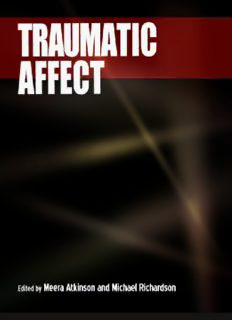
Traumatic Affect PDF
Preview Traumatic Affect
Traumatic Affect Traumatic Affect Edited by Meera Atkinson and Michael Richardson Traumatic Affect, Edited by Meera Atkinson and Michael Richardson This book first published 2013 Cambridge Scholars Publishing 12 Back Chapman Street, Newcastle upon Tyne, NE6 2XX, UK British Library Cataloguing in Publication Data A catalogue record for this book is available from the British Library Copyright © 2013 by Meera Atkinson and Michael Richardson and contributors All rights for this book reserved. No part of this book may be reproduced, stored in a retrieval system, or transmitted, in any form or by any means, electronic, mechanical, photocopying, recording or otherwise, without the prior permission of the copyright owner. ISBN (10): 1-4438-4867-0, ISBN (13): 978-1-4438-4867-1 TABLE OF CONTENTS Acknowledgments .................................................................................... vii Introduction ................................................................................................ 1 At the Nexus Meera Atkinson and Michael Richardson Part I: Silence Chapter One .............................................................................................. 22 Benjamin’s Silence Shoshana Felman Chapter Two ............................................................................................. 59 “Un Petit Geste”: Affect and Silence in Claude Lanzmann’s Shoah Magdalena Zolkos Chapter Three ........................................................................................... 80 Film, Trauma and the Enunciative Present Anne Rutherford Part II: Cultures Chapter Four ........................................................................................... 104 The Earthquake After Kant’s Lisbon: “Visceral Reason” in Kleist’s Precarious Modernity Karyn Ball Chapter Five ........................................................................................... 129 Apparently Unrelated: Affective Resonance, Concatenation and Traumatic Circuitry in the Terrain of the Everyday Anna Gibbs Chapter Six ............................................................................................. 148 Torturous Affect: Writing and the Problem of Pain Michael Richardson vi Table of Contents Part III: Mediatized Chapter Seven ......................................................................................... 172 Gojira’s Bones: The Monster as a Vessel of Affective Energy Aaron Kerner Chapter Eight .......................................................................................... 193 The Mediatization of Trauma and the Trauma of Mediatization: Benjamin, Tulloch, and the Struggle to Speak Ben O’Loughlin Chapter Nine ........................................................................................... 213 Where the Buffalo No Longer Roam: Affect and Allegory in The Last Hunt and The Last Buffalo Hunt Jonathan L. Knapp Part IV: Embodied Chapter Ten ............................................................................................ 230 Radical Realism and Other Possibilities in Contemporary Intercultural Indigenous Australian Cinema Jennifer L. Biddle Chapter Eleven ....................................................................................... 240 Trauma Stimulated Art, or the Embodiment of Affect in Lebanon: An Allegory Ricardo Mbarkho Chapter Twelve ...................................................................................... 247 Channeling the Specter and Translating Phantoms: Hauntology and the Spooked Text Meera Atkinson Bibliography ........................................................................................... 271 Contributors ............................................................................................ 290 Index ....................................................................................................... 294 ACKNOWLEDGMENTS Traumatic Affect, a collection of essays from contributors around the world, was conceived and developed within the Writing and Society Research Centre at the University of Western Sydney, Australia. The Centre hosted a public symposium on “Trauma: Writing, Art and Affect” in April 2011, which we convened, and has since supported the production of this book. We owe thanks to Anthony Uhlman, Ivor Indyk, our invaluable copyeditor and indexer Melinda Jewell, and all those in the Centre who pitched in along the way. We also wish to thank the participants and attendees of the 2011 symposium, several of whom appear in this volume, who helped begin the dialogue of which Traumatic Affect is the result. We would like to extend a special thanks to Anna Gibbs, Magdalena Zolkos, Deborah Staines and Catherine Camden-Pratt for their encouragement and assistance, and we are indebted to Kylie Boxall for her striking work on the cover image. Last but certainly not least, we thank the contributors to this collection who have so generously participated in this project, delivering powerful essays on the nexus of trauma and affect. Shoshana Felman’s essay “Benjamin’s Silence” was previously published in Critical Inquiry Vol. 25 No. 2 (1999). Jennifer L. Biddle’s chapter “Radical Realism and Other Possibilities in Contemporary Intercultural Indigenous Australian Cinema” was developed from an essay written for the Sydney Un_imaginable exhibition catalogue, published in-house by Ivan-Dougherty Gallery (2008). INTRODUCTION AT THE NEXUS MEERA ATKINSON AND MICHAEL RICHARDSON The story of trauma [. . .] as the narrative of a belated experience, far from telling of an escape from reality—the escape from a death, or from its referential force—rather attests to its endless impact on a life. —Cathy Caruth, UnclaimedExperience, 7. Affect is an impingement or extrusion of a momentary or sometimes more sustained state of relation as well as the passage (and the duration of passage) of forces or intensities. That is, affect is found in those intensities that pass body to body (human, nonhuman, part-body, and otherwise), in those resonances that circulate about, between, and sometimes stick to bodies and worlds, and in their very passages or variations between these intensities and resonances themselves. —Melissa Gregg & Gregory Seigworth, The Affect Theory Reader, 1. These quotes gesture towards the heart of this collection: the question of how trauma might be approached with respect for, and recognition of, its existence, recurrence, and lived presence as an “impossible event,” while nonetheless examining the form, substance and dynamics of that impossibility in new ways. How might we recognize the continuum between personal and collective, without collapsing them into dichotomy? How can we think about trauma in terms of present relation rather than absence or disconnection? How would we re-imagine the transmission of trauma between bodies? How might we acknowledge, and even intervene upon, the cycle of affect and effect between individual and collective, familial and national? It is the contention of this volume that thinking trauma in terms of affect offers enormous promise. In what follows, we aim to set out a theoretical topology of the intersection of trauma and affect. Our intent here is not to provide a complete account of either field,
Description: